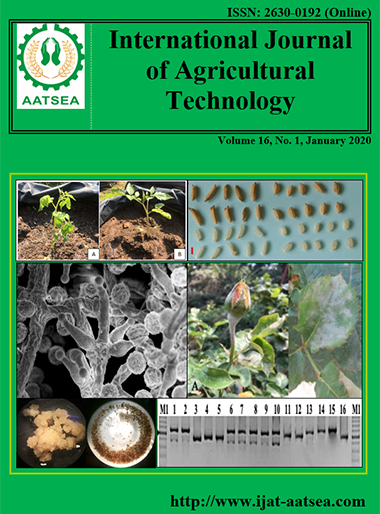Quality and stability of reduced-fat fermented pork sausage (Sai Krok E-san) with konjac gel during chilled storage
Main Article Content
Abstract
The quality and shelflife of reduced-fat Thai fermented pork sausage (Sai Krok E-san) wereevaluated andthe effect of replacing pork backfat with konjac gel on the changes in qualities during chilled storage was measured. Weight loss, pH, color and protein degradation between control (30% pork back fat) and reduced-fat products (50% of substitution pork back fat with konjac gel) were not significantly different (p<0.05). However, reduced-fat product with konjac gel exhibited a superior texture, with higher values for hardness, cohesiveness, gumminess, springiness and chewiness (p<0.05). During the 2 weeks of storage, lipid oxidation was lower in the reduced-fat sample (p<0.05) when compared with the control, thereafter these values for both products were increased without significant differences (p>0.05). Although lactic acid bacteria (LAB) were not influenced by the reformulation (p<0.05), LAB gradually increased during storage and ranged from 8 log CFU/g at the begining to 9 log CFU/g after 4 weeks. The sensory panel stated that both products had acceptable sensory quality if the products were kept less than 3 weeks. Longer periods led to a more rancid flavor, especially in the control sample.
Article Details

This work is licensed under a Creative Commons Attribution-NonCommercial-NoDerivatives 4.0 International License.
References
Bennett, R. W. and Lancette, G. A. (2001). Staphylococcus aureus. Bacteriological analytical manual (BAM). U.S. Food and Drug Administration. Retrieved from https://www.fda.gov/food/foodscienceresearch/laboratorymethods/ucm071429.htm.
Berry, B. W. and Bigner, M. E. (1996). Use of carrageenan and konjac flour gel in low-fat restructured pork nuggets. Food Research International, 29:355-362.
Buege, J. A. and Aust, S. D. (1978). Microsomal lipid peroxidation. Methods in Enzymology, 52:302-304.
Chin, K. B., Keeton, J. T., Miller, R. K, Longnecker, M. T. and Lamkey, J. W. (2000). Evaluation of konjac blends and soy protein isolate as fat replacements in low-fat bologna. Journal of Food Science, 65:756-763.
Feng, P., Weagant, S. D., Grant, M. A. and Burkhardt, W. (2002). Enumeration of Escherichia coli and the coliform bacteria in food. Bacteriological analytical manual (BAM). U.S. Food and Drug Administration. Retrieved from https://www.fda.gov/Food/FoodScience
Research/LaboratoryMethods/ucm064948.htm.
International Organization for Standardization (2002). ISO 6579: 2002. Microbiology of food and animal feeding stuffs-horizontal method for the detection. 4th ed. Retrieved fromhttps://www.iso.org/standard/56712.html.
Jiménez-Colmenero, F., Cofrades, S., López-López, I., Ruiz-Capillas, C., Pintado, T. and Solas, M. T. (2010). Technological and sensory characteristics of reduced/low-fat, low-salt frankfurters as affected by the addition of konjac and seaweed. Meat Science, 84:356-363.
Kheadr, E. (2006). Impact of acid and oxgall on antibiotic susceptibility of probiotic Lactobacilli. African Journal of Agricultural Research, 1:172-181.
Morrissey, M. T., Wu, J. W., Lin, D. and An, H. (1993). Protease inhibitor effects on torsion measurements and autolysis of Pacific whiting surimi. Journal of Food Science, 58:1050-1054.
Osburn, W. N. and Keeton, J. T. (2004). Evaluation of low-fat sausage containing desinewed lamb and konjac Gel. Meat Science, 68:221-233.
Osei Abunyewa, A. A., Laing, E., Hugo, A. and Viljoen, B. C. (2000). The population change of yeasts in commercial salami. Food Microbiology, 17:429-438.
Ruiz-Capillas, C., Triki, M., Herrero, A. M., Rodriguez-Salas, L. and Jimenez-Colmenero, F. (2012). Konjac gel as pork back fat replacer in dry fermented sausages: Processing and quality characteristics. Meat Science, 92:144-150.
Selgas, M. D. and Garcia, M. L. (2015). Yeasts. In: Toldrá F. ed. Handbook of fermented meat and poultry. Oxford, Joh Wiley & Sons, Ltd., pp.139-146.
Sorapukdee, S., Jansa, S. and Tangwatcharin, P. (2019). Partial replacement of pork backfat with konjac gel in Northeastern Thai fermented sausage (Sai Krok E-san) to produce the healthier product. Asian-Australasian Journal of Animal Science, 32:1763-1775.
Thai community product standard (2012). Sandard No. 144-2555: Fermented pork sausages, Sai Krok E-San Mu. Thai Industrial Standards Institute. Retrieved from http://tcps.tisi.go.th/public/StandardList.aspx.
Triki, M., Herrero, A. M., Jiménez-Colmenero, F. and Ruiz-Capillas, C. (2013). Effect of preformed konjac gels, with and without olive oil, on the technological attributes and storage stability of merguez sausage. Meat Science, 93:351-360.
Visessanguan, W., Benjakul, S., Riebroy, S. and Thepkasikul, P. (2004). Changes in composition and functional properties of proteins and their contributions to Nham characteristics. Meat Science, 66:579-588.
World Health Organization (2003). Diet, nutrition, and the prevention of chronic diseases: Report of the joint WHO/FAO expert consultation WHO Technical Report Series, No. 916 (TRS 916). Retrieved from https://www.who.int/dietphysicalactivity/publications/trs916/en/.


